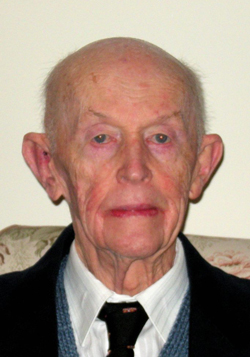A geoscientist of international repute with strong links to South Africa and the Quaternary Geology of the African continent

Herbert Basil Sutton Cooke, passed away peacefully on 3 May 2018 at 102 years of age. Born in Johannesburg on 17 October 1915, Basil was the last surviving member of a group of pioneering African palaeontologists, which included Robert Broom, Raymond Dart, John Robinson and Phillip Tobias in South Africa, as well as Louis Leakey in East Africa.
Educated at King Edward VII School, Johannesburg, Cambridge University (B.A. [Hons] Geology and M.A., 1936-1940), and the University of the Witwatersrand (M.Sc. and D.Sc., 1940-1947), he went on to teach at the University of the Witwatersrand from 1938-1947. From 1941-1945, he also served with the South African Air Force during the Second World War as observer and meteorologist, and held the rank of Captain.
In 1953, following a stint as a private Consulting Geologist, he returned to Witwatersrand University as a Senior Lecturer, and between 1958 and 1961 held the title of Reader in Stratigraphic Geology. In 1961 he moved to Halifax, Nova Scotia, Canada, where he was professor of Geology at Dalhousie University, holding the Carnegie Professorship from 1969 onwards and acting as Dean of the Faculty of Arts and Science for five years. He retired in 1981 and, together with his wife Dorette, moved to White Rock, British Columbia.
Research
Academic communities around the world knew Basil best as one of the pioneering African palaeontologists. He took a keen interest in Hominid Evolution and played a significant role in understanding the geology of the famous Sterkfontein Caves site (Maropeng). Although he was a geological ‘all-rounder’, his personal specialty was Quaternary Geology and he made notable contributions in a series of papers on the alluvial terraces of the lower Vaal River, famous for the Stone Age artefacts and vertebrate fossils revealed in pits excavated by scores of diamond diggers. He made major contributions working on fossil African pigs, as well as Hominin environments in the East African Pliocene.
In later years, Basil was drawn into the work of the International Union for Quaternary Research where, as a member of their policy-setting body—the Commission on Stratigraphy—he made telling inputs, which led to the defining of the present geological boundary between the Pliocene and Pleistocene epochs.
Accolades
In 2018, Basil celebrated the 68th anniversary of his election, at an exceptionally young age, to Fellowship of the Royal Society of South Africa. He was also a Fellow of the Geological Society of South Africa, an Honorary Member of the Palaeontological Society of Southern Africa, Past President and Member of both the South African Geographical and Archaeological societies, and a Past Vice-president of the South African Association for the Advancement of Science. In Canada, Basil was made an Honorary Member of the Nova Scotian Institute of Science and the Canadian Association for Physical Anthropology. He was awarded the Canadian Centennial Medal (1967) and Queen’s Golden Jubilee Medal (2002) for his contributions to education.
His awards over the years have been many and varied, including an LL.D. honoris causa by Dalhousie University in 1982 and a D.Sc. honoris causa by his alma mater, the University of the Witwatersrand, in 1998.
Basil was predeceased by Dorette, his wife of more than 60 years. He leaves behind two sons, Christopher (Sharron) and Patrick (Phyllis), and three grandsons, Brandon, Christian, and Justin.
By Carl R. Anhaeusser
(This obituary is modified from the original version by Carl R. Anhaeusser, reprinted with kind permission from the Geological Society of South Africa, Geobulletin, June 2018; The full original version of this piece appears on page 27 of the GSSA Geobulletin, June 2018 here: https://gssa.pub/gb/content/2018/gb_v61n2_june-2018_archive.pdf. Editor.)